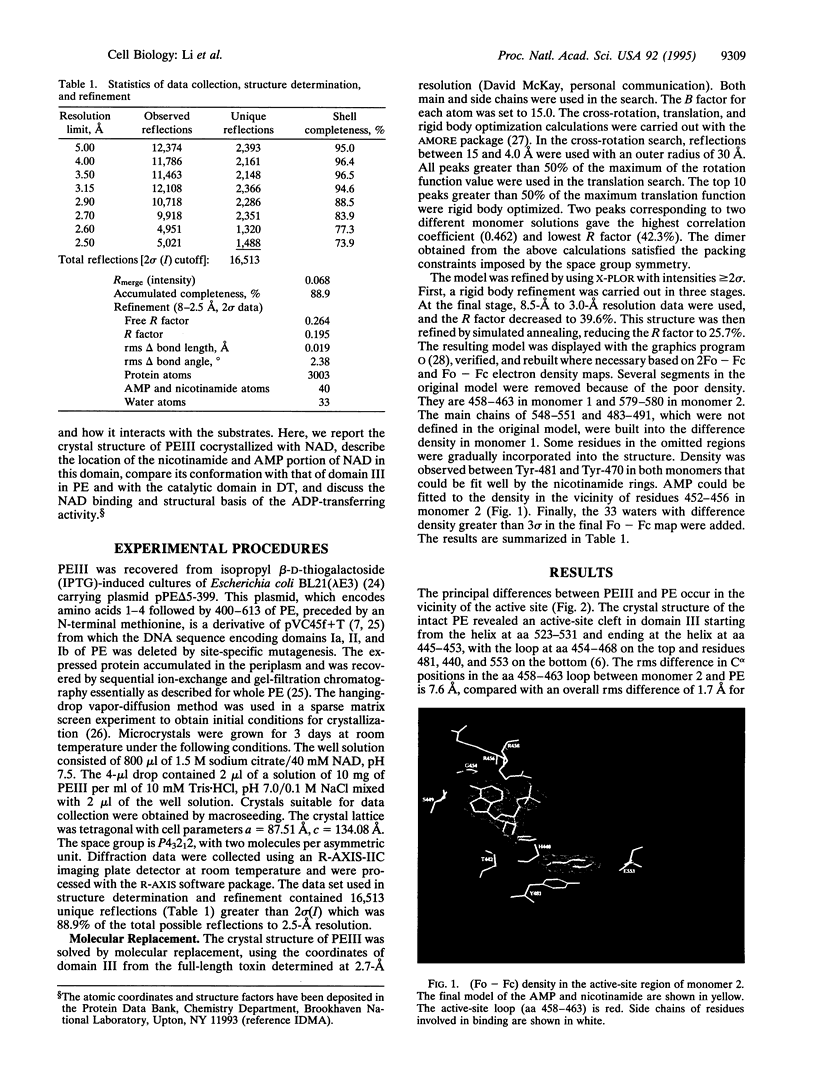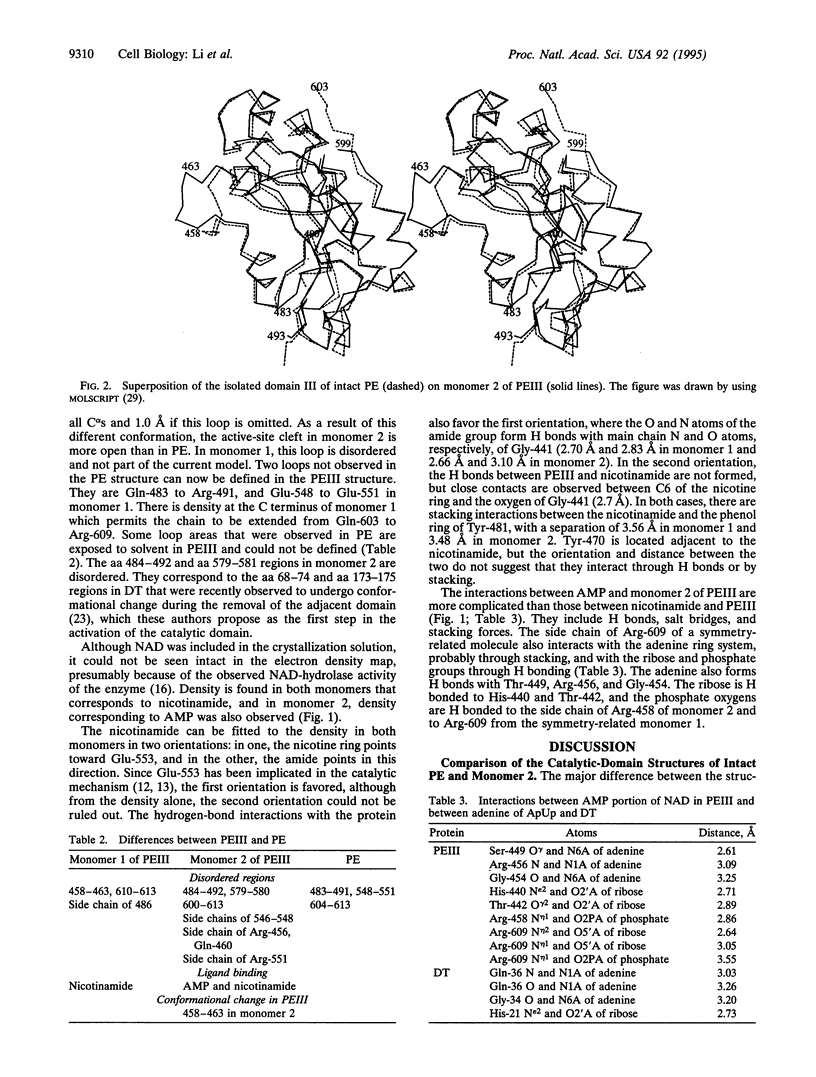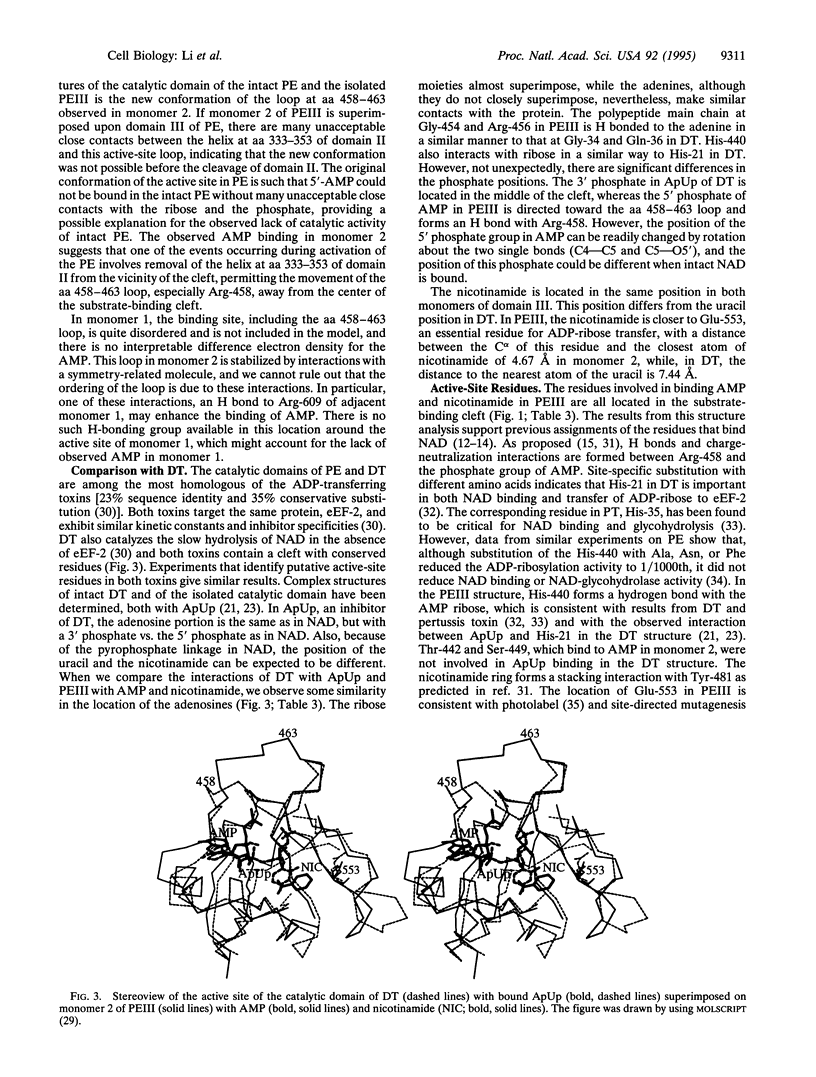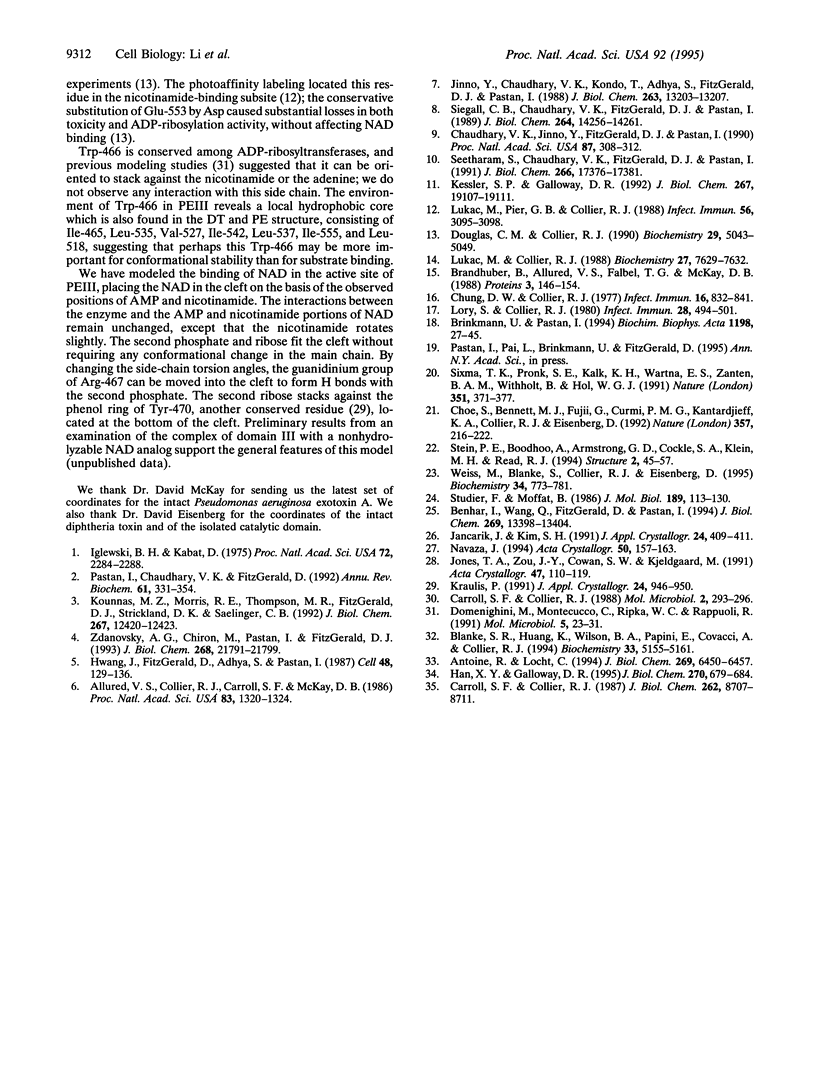Abstract
Domain III of Pseudomonas aeruginosa exotoxin A catalyses the transfer of ADP-ribose from NAD to a modified histidine residue of elongation factor 2 in eukaryotic cells, thus inactivating elongation factor 2. This domain III is inactive in the intact toxin but is active in the isolated form. We report here the 2.5-A crystal structure of this isolated domain crystallized in the presence of NAD and compare it with the corresponding structure in the intact Pseudomonas aeruginosa exotoxin A. We observe a significant conformational difference in the active site region from Arg-458 to Asp-463. Contacts with part of domain II in the intact toxin prevent the adoption of the isolated domain conformation and provide a structural explanation for the observed inactivity. Additional electron density in the active site region corresponds to separate AMP and nicotinamide and indicates that the NAD has been hydrolyzed. The structure has been compared with the catalytic domain of the diphtheria toxin, which was crystallized with ApUp.
Full text
PDF




Images in this article
Selected References
These references are in PubMed. This may not be the complete list of references from this article.
- Allured V. S., Collier R. J., Carroll S. F., McKay D. B. Structure of exotoxin A of Pseudomonas aeruginosa at 3.0-Angstrom resolution. Proc Natl Acad Sci U S A. 1986 Mar;83(5):1320–1324. doi: 10.1073/pnas.83.5.1320. [DOI] [PMC free article] [PubMed] [Google Scholar]
- Antoine R., Locht C. The NAD-glycohydrolase activity of the pertussis toxin S1 subunit. Involvement of the catalytic HIS-35 residue. J Biol Chem. 1994 Mar 4;269(9):6450–6457. [PubMed] [Google Scholar]
- Benhar I., Wang Q. C., FitzGerald D., Pastan I. Pseudomonas exotoxin A mutants. Replacement of surface-exposed residues in domain III with cysteine residues that can be modified with polyethylene glycol in a site-specific manner. J Biol Chem. 1994 May 6;269(18):13398–13404. [PubMed] [Google Scholar]
- Blanke S. R., Huang K., Wilson B. A., Papini E., Covacci A., Collier R. J. Active-site mutations of the diphtheria toxin catalytic domain: role of histidine-21 in nicotinamide adenine dinucleotide binding and ADP-ribosylation of elongation factor 2. Biochemistry. 1994 May 3;33(17):5155–5161. doi: 10.1021/bi00183a019. [DOI] [PubMed] [Google Scholar]
- Brandhuber B. J., Allured V. S., Falbel T. G., McKay D. B. Mapping the enzymatic active site of Pseudomonas aeruginosa exotoxin A. Proteins. 1988;3(3):146–154. doi: 10.1002/prot.340030303. [DOI] [PubMed] [Google Scholar]
- Brinkmann U., Pastan I. Immunotoxins against cancer. Biochim Biophys Acta. 1994 May 27;1198(1):27–45. doi: 10.1016/0304-419x(94)90004-3. [DOI] [PubMed] [Google Scholar]
- Carroll S. F., Collier R. J. Active site of Pseudomonas aeruginosa exotoxin A. Glutamic acid 553 is photolabeled by NAD and shows functional homology with glutamic acid 148 of diphtheria toxin. J Biol Chem. 1987 Jun 25;262(18):8707–8711. [PubMed] [Google Scholar]
- Carroll S. F., Collier R. J. Amino acid sequence homology between the enzymic domains of diphtheria toxin and Pseudomonas aeruginosa exotoxin A. Mol Microbiol. 1988 Mar;2(2):293–296. doi: 10.1111/j.1365-2958.1988.tb00031.x. [DOI] [PubMed] [Google Scholar]
- Chaudhary V. K., Jinno Y., FitzGerald D., Pastan I. Pseudomonas exotoxin contains a specific sequence at the carboxyl terminus that is required for cytotoxicity. Proc Natl Acad Sci U S A. 1990 Jan;87(1):308–312. doi: 10.1073/pnas.87.1.308. [DOI] [PMC free article] [PubMed] [Google Scholar]
- Choe S., Bennett M. J., Fujii G., Curmi P. M., Kantardjieff K. A., Collier R. J., Eisenberg D. The crystal structure of diphtheria toxin. Nature. 1992 May 21;357(6375):216–222. doi: 10.1038/357216a0. [DOI] [PubMed] [Google Scholar]
- Chung D. W., Collier R. J. Enzymatically active peptide from the adenosine diphosphate-ribosylating toxin of Pseudomonas aeruginosa. Infect Immun. 1977 Jun;16(3):832–841. doi: 10.1128/iai.16.3.832-841.1977. [DOI] [PMC free article] [PubMed] [Google Scholar]
- Domenighini M., Montecucco C., Ripka W. C., Rappuoli R. Computer modelling of the NAD binding site of ADP-ribosylating toxins: active-site structure and mechanism of NAD binding. Mol Microbiol. 1991 Jan;5(1):23–31. doi: 10.1111/j.1365-2958.1991.tb01822.x. [DOI] [PubMed] [Google Scholar]
- Douglas C. M., Collier R. J. Pseudomonas aeruginosa exotoxin A: alterations of biological and biochemical properties resulting from mutation of glutamic acid 553 to aspartic acid. Biochemistry. 1990 May 29;29(21):5043–5049. doi: 10.1021/bi00473a007. [DOI] [PubMed] [Google Scholar]
- Han X. Y., Galloway D. R. Active site mutations of Pseudomonas aeruginosa exotoxin A. Analysis of the His440 residue. J Biol Chem. 1995 Jan 13;270(2):679–684. doi: 10.1074/jbc.270.2.679. [DOI] [PubMed] [Google Scholar]
- Hwang J., Fitzgerald D. J., Adhya S., Pastan I. Functional domains of Pseudomonas exotoxin identified by deletion analysis of the gene expressed in E. coli. Cell. 1987 Jan 16;48(1):129–136. doi: 10.1016/0092-8674(87)90363-1. [DOI] [PubMed] [Google Scholar]
- Iglewski B. H., Kabat D. NAD-dependent inhibition of protein synthesis by Pseudomonas aeruginosa toxin,. Proc Natl Acad Sci U S A. 1975 Jun;72(6):2284–2288. doi: 10.1073/pnas.72.6.2284. [DOI] [PMC free article] [PubMed] [Google Scholar]
- Jinno Y., Chaudhary V. K., Kondo T., Adhya S., FitzGerald D. J., Pastan I. Mutational analysis of domain I of Pseudomonas exotoxin. Mutations in domain I of Pseudomonas exotoxin which reduce cell binding and animal toxicity. J Biol Chem. 1988 Sep 15;263(26):13203–13207. [PubMed] [Google Scholar]
- Jones T. A., Zou J. Y., Cowan S. W., Kjeldgaard M. Improved methods for building protein models in electron density maps and the location of errors in these models. Acta Crystallogr A. 1991 Mar 1;47(Pt 2):110–119. doi: 10.1107/s0108767390010224. [DOI] [PubMed] [Google Scholar]
- Kessler S. P., Galloway D. R. Pseudomonas aeruginosa exotoxin A interaction with eucaryotic elongation factor 2. Role of the His426 residue. J Biol Chem. 1992 Sep 25;267(27):19107–19111. [PubMed] [Google Scholar]
- Kounnas M. Z., Morris R. E., Thompson M. R., FitzGerald D. J., Strickland D. K., Saelinger C. B. The alpha 2-macroglobulin receptor/low density lipoprotein receptor-related protein binds and internalizes Pseudomonas exotoxin A. J Biol Chem. 1992 Jun 25;267(18):12420–12423. [PubMed] [Google Scholar]
- Lory S., Collier R. J. Expression of enzymic activity by exotoxin A from Pseudomonas aeruginosa. Infect Immun. 1980 May;28(2):494–501. doi: 10.1128/iai.28.2.494-501.1980. [DOI] [PMC free article] [PubMed] [Google Scholar]
- Lukac M., Collier R. J. Pseudomonas aeruginosa exotoxin A: effects of mutating tyrosine-470 and tyrosine-481 to phenylalanine. Biochemistry. 1988 Oct 4;27(20):7629–7632. doi: 10.1021/bi00420a009. [DOI] [PubMed] [Google Scholar]
- Lukac M., Pier G. B., Collier R. J. Toxoid of Pseudomonas aeruginosa exotoxin A generated by deletion of an active-site residue. Infect Immun. 1988 Dec;56(12):3095–3098. doi: 10.1128/iai.56.12.3095-3098.1988. [DOI] [PMC free article] [PubMed] [Google Scholar]
- Pastan I., Chaudhary V., FitzGerald D. J. Recombinant toxins as novel therapeutic agents. Annu Rev Biochem. 1992;61:331–354. doi: 10.1146/annurev.bi.61.070192.001555. [DOI] [PubMed] [Google Scholar]
- Seetharam S., Chaudhary V. K., FitzGerald D., Pastan I. Increased cytotoxic activity of Pseudomonas exotoxin and two chimeric toxins ending in KDEL. J Biol Chem. 1991 Sep 15;266(26):17376–17381. [PubMed] [Google Scholar]
- Siegall C. B., Chaudhary V. K., FitzGerald D. J., Pastan I. Functional analysis of domains II, Ib, and III of Pseudomonas exotoxin. J Biol Chem. 1989 Aug 25;264(24):14256–14261. [PubMed] [Google Scholar]
- Sixma T. K., Pronk S. E., Kalk K. H., Wartna E. S., van Zanten B. A., Witholt B., Hol W. G. Crystal structure of a cholera toxin-related heat-labile enterotoxin from E. coli. Nature. 1991 May 30;351(6325):371–377. doi: 10.1038/351371a0. [DOI] [PubMed] [Google Scholar]
- Stein P. E., Boodhoo A., Armstrong G. D., Cockle S. A., Klein M. H., Read R. J. The crystal structure of pertussis toxin. Structure. 1994 Jan 15;2(1):45–57. doi: 10.1016/s0969-2126(00)00007-1. [DOI] [PubMed] [Google Scholar]
- Studier F. W., Moffatt B. A. Use of bacteriophage T7 RNA polymerase to direct selective high-level expression of cloned genes. J Mol Biol. 1986 May 5;189(1):113–130. doi: 10.1016/0022-2836(86)90385-2. [DOI] [PubMed] [Google Scholar]
- Weiss M. S., Blanke S. R., Collier R. J., Eisenberg D. Structure of the isolated catalytic domain of diphtheria toxin. Biochemistry. 1995 Jan 24;34(3):773–781. doi: 10.1021/bi00003a010. [DOI] [PubMed] [Google Scholar]
- Zdanovsky A. G., Chiron M., Pastan I., FitzGerald D. J. Mechanism of action of Pseudomonas exotoxin. Identification of a rate-limiting step. J Biol Chem. 1993 Oct 15;268(29):21791–21799. [PubMed] [Google Scholar]



